Modular Construction Market Size
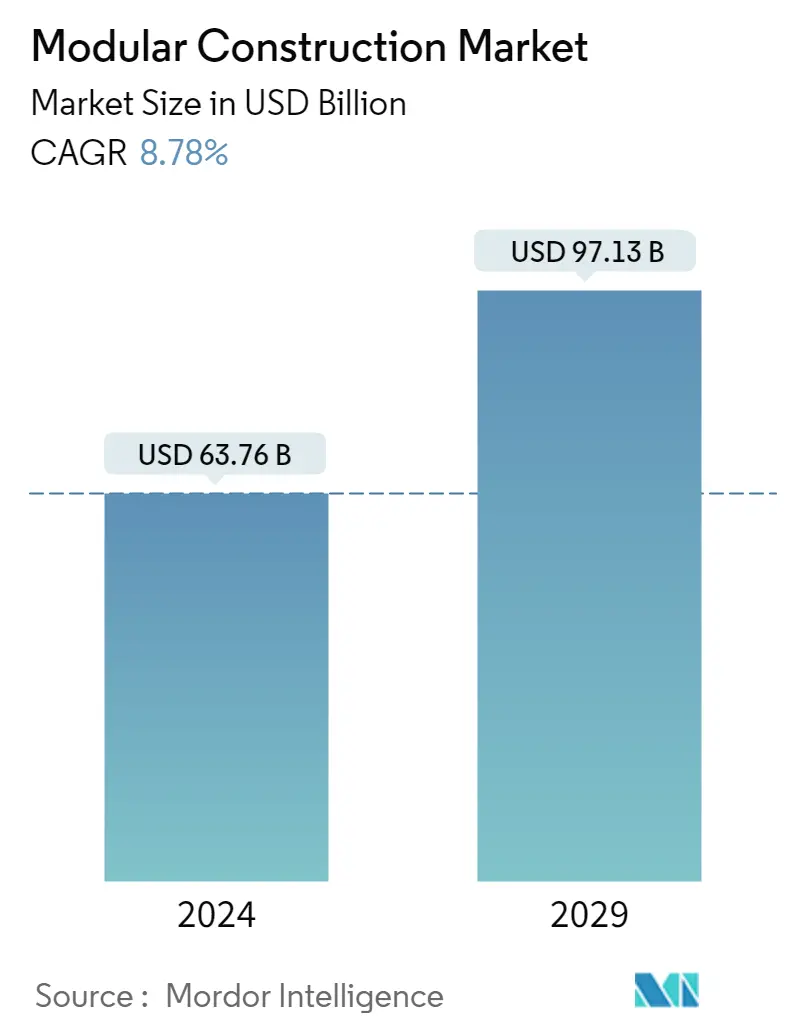
| Study Period | 2019 - 2029 |
| Market Size (2024) | USD 63.76 Billion |
| Market Size (2029) | USD 97.13 Billion |
| CAGR (2024 - 2029) | 8.78 % |
| Fastest Growing Market | Asia Pacific |
| Largest Market | Asia Pacific |
Major Players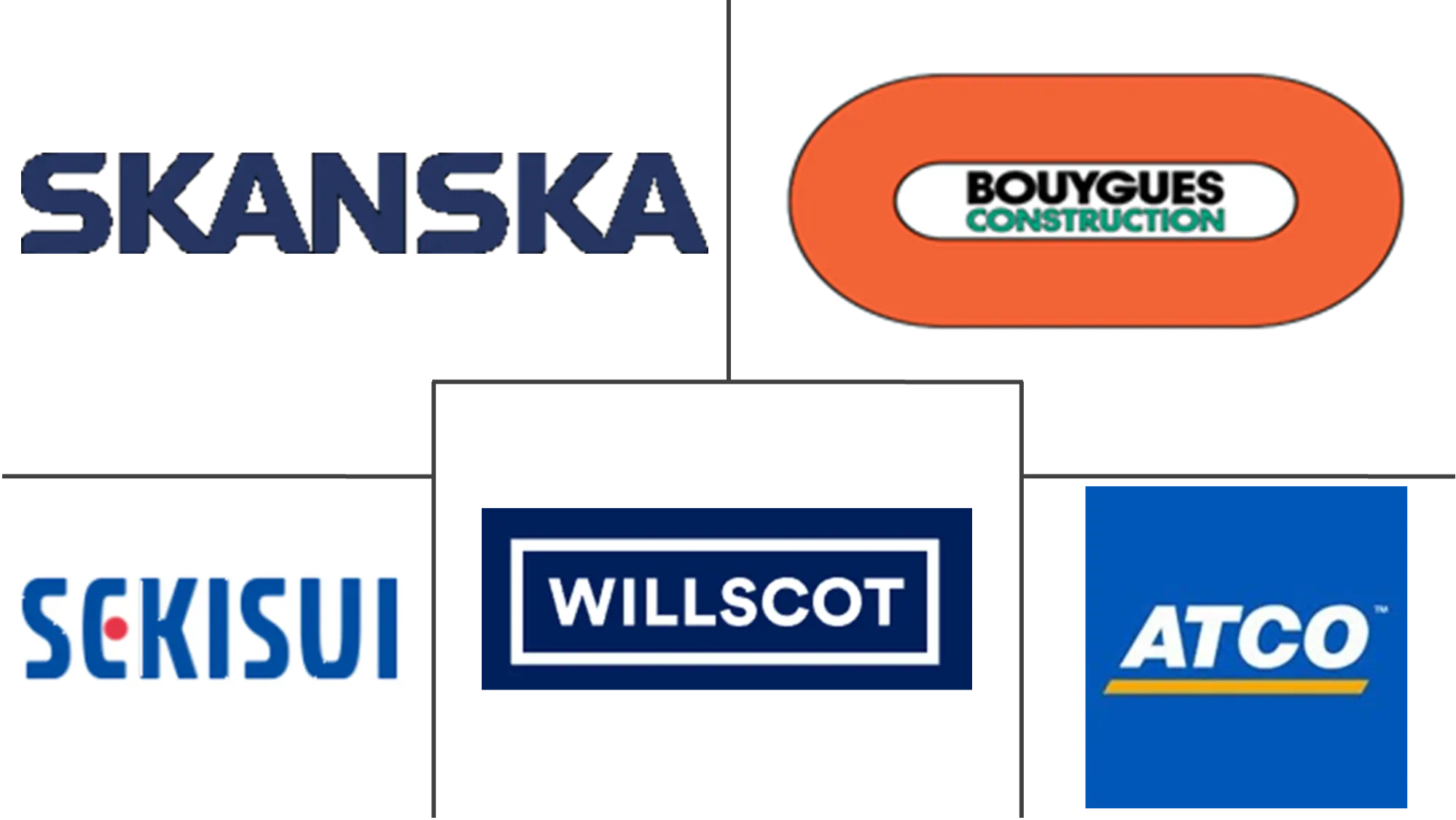
*Disclaimer: Major Players sorted in no particular order |
Need a report that reflects how COVID-19 has impacted this market and its growth?
Modular Construction Market Analysis
The Modular Construction Market size is estimated at USD 63.76 billion in 2024, and is expected to reach USD 97.13 billion by 2029, growing at a CAGR of 8.78% during the forecast period (2024-2029).
The sporadic outbreak of the COVID-19 pandemic in 2020 and the first half of 2021 drastically curtailed the construction sector due to imposed government bans and restrictions, thereby limiting the growth of the modular construction market. However, the sector has been recovering well since restrictions were lifted. An increase in house sales, new project launches, and increasing demand for new offices and commercial spaces have been leading the market recovery over the last two years.
- Rising demand from construction industries in countries of Asia-Pacific and the time and cost-effectiveness of modular construction work with lower defects and reworks needed are expected to drive the market's growth.
- On the flip side, the high cost of logistics involved in modular construction is expected to hinder the growth of the market studied.
- The construction industry has been exploring innovative materials and technologies that can provide more high-quality housing using less construction time. The implementation of building information modeling (BIM) and potential savings in cost due to the adoption of modular construction will likely provide new growth opportunities for the market.
- Asia-Pacific dominated the market across the world, with the largest consumption from countries, such as Japan, China, and South Korea.
Modular Construction Market Trends
Increasing Demand from the Industrial/Institutional Sector
- The industrial/institutional sector is the largest segment in the modular construction market. Institutional buildings are constructed using the modular construction process in accordance with the International Building Code (IBC) or a version of a code modeled after the IBC and state regulations.
- The increasing demand for modular construction in Asia-Pacific is moving much of the construction process from the building site into factories. "While countries like China, Japan, Singapore, and Australia are increasingly adopting modular buildings to meet labor and housing shortages, increase in industrialization, rising urbanized population, rising demand for eco-friendly and sustainable construction and government support."
- Government initiatives to reduce waste and promote green construction and building techniques are driving the demand for modular construction. For example, Singapore has mandated elements of prefabricated, pre-finished, and volumetric construction (PPVC) for all the projects on the government's land. This is backed by subsidies for companies that participate with the aim of increasing and standardizing modern methods of construction (MMC) in the country, thereby increasing the demand for off-site construction.
- According to the National Bureau of Statistics of China, the country's construction output peaked in 2022 at about CNY 31.20 (~USD 4.61 trillion). Thereby supporting the market demand.
- According to EU Industrial R&D Investment Scoreboard, Europe's industrial sector is back on track in research and development investments with an increase of 8.9% in 2021 compared to the -2.2 % pandemic-related dip in 2020.
- Globally, the private sector R&D investment in industrial construction grew strongly beyond pre-pandemic levels by 14.8% in 2021 (compared to 2020).
- According to the American Institute of Architects, in the United States, spending in education space, which declined by an estimated -6.6% in 2021, is expected to rise by 2.7% in 2022. Spending in health facilities rose by an estimated 1.2% in 2021, and it is expected to rise by 2.4% in 2022.
- According to the European Investment Bank Group, the bank provided EUR 99 million (~USD 105.48 million) loan to Hemsö Fastighets AB to create more energy-efficient social infrastructure in Sweden and Finland. Nine buildings for social services will be built, including nursing homes, a medical facility, preschools, and school services.
- Therefore, the above factors are expected to have a significant impact on the market in the coming years.
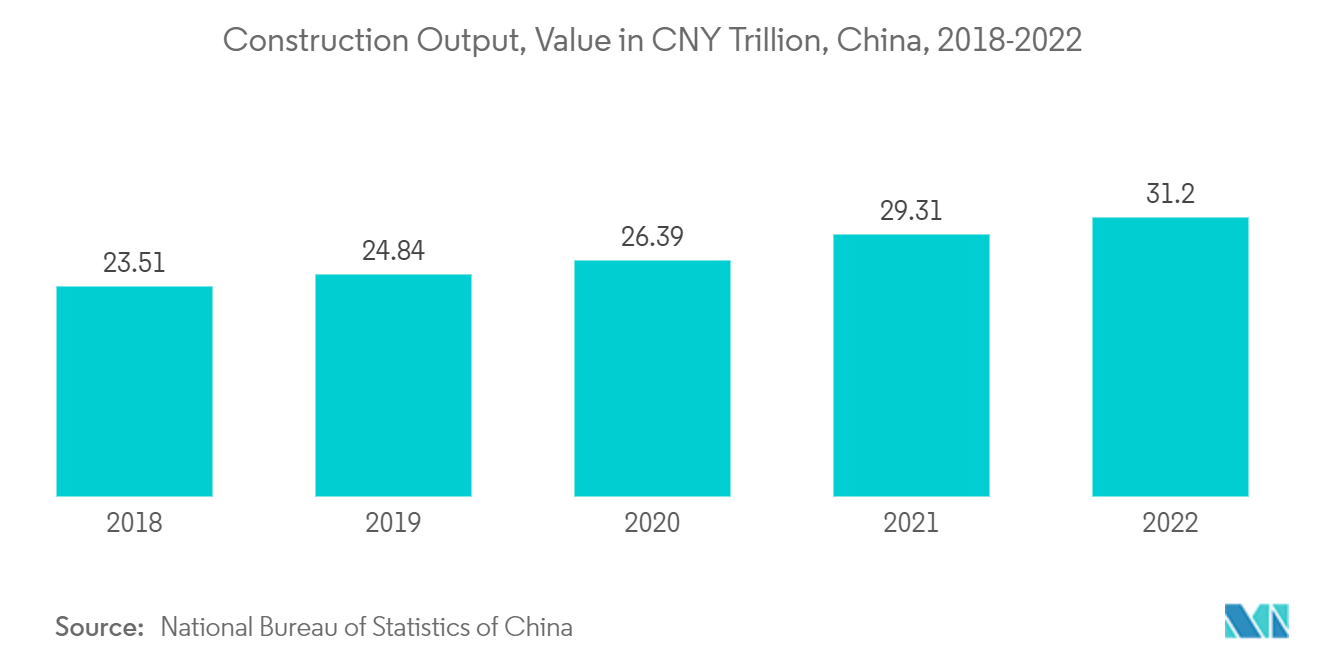
Asia-Pacific Region to Dominate the Market
- The Asia-Pacific region stands to be the largest and fastest-growing market for the construction industry. Factors, such as expansion in the residential and commercial construction sector, will drive market growth in the region.
- Further, rising investments in infrastructural construction projects in the private and public sectors in developing countries, such as India and China, have proliferated the growth of the Asia-Pacific modular construction market.
- The rising household income levels, combined with the population migrating from rural to urban areas, are expected to continue to drive the demand in the residential construction sector in the region. The increased focus on affordable housing by both the public and private sectors is driving the growth in the residential construction sector.
- Non-residential infrastructure is expected to grow considerably. The aging population in the country is creating a demand for the construction of healthcare facilities and new hospitals. The structural changes in the Chinese economy over the past few years, with the service sector taking a larger share of the total GDP, are giving rise to the construction of huge commercial and office spaces.
- China has the largest construction market in the world, encompassing 20% of all construction investments globally. China is expected to spend nearly USD 13 trillion on buildings by 2030, creating a positive market outlook for the modular construction market.
- India plans to spend USD 1.4 trillion on infrastructure through the 'National Infrastructure Pipeline' in the next five years, as reported in 2022. In FY21, infrastructure activities accounted for a 13% share of the total FDI inflows of USD 81.72 billion.
- According to Singapore's Central Bank, the country is planning on investing over USD 2.7 billion in infrastructure and housing projects. The government announced that the public sector will be issuing up to SGD 35 billion (~USD25.3 billion) of green bonds to finance sustainable infrastructure projects by 2030.
- Thus, the factors mentioned above are expected to boost the demand for the modular construction market in the region in the coming years.
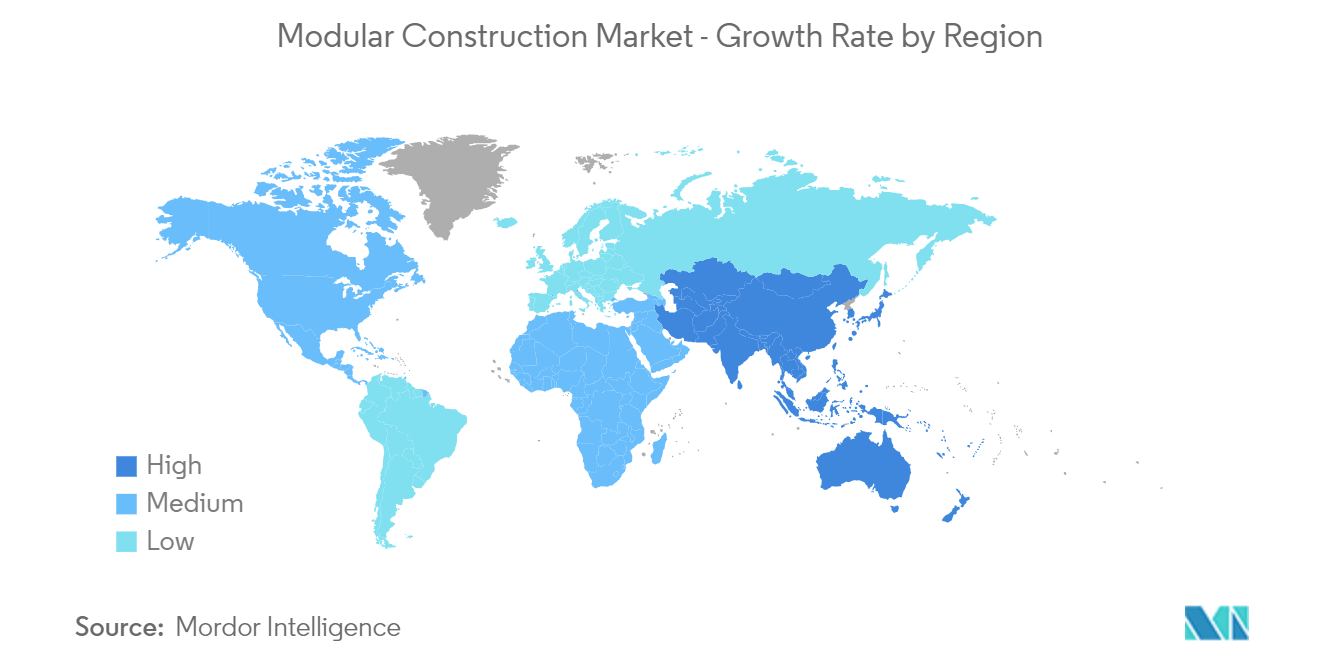
Modular Construction Industry Overview
The modular construction market is highly fragmented in nature. The major players in the studied market (not in any particular order) include Skanska, Bouygues Construction, WillScot Mobile Mini Holdings Corp., ATCO Ltd, and SEKISUI CHEMICAL CO., LTD, among others.
Modular Construction Market Leaders
Skanska
Bouygues Construction
WillScot Mobile Mini Holdings Corp.
ATCO Ltd
SEKISUI CHEMICAL CO., LTD
*Disclaimer: Major Players sorted in no particular order
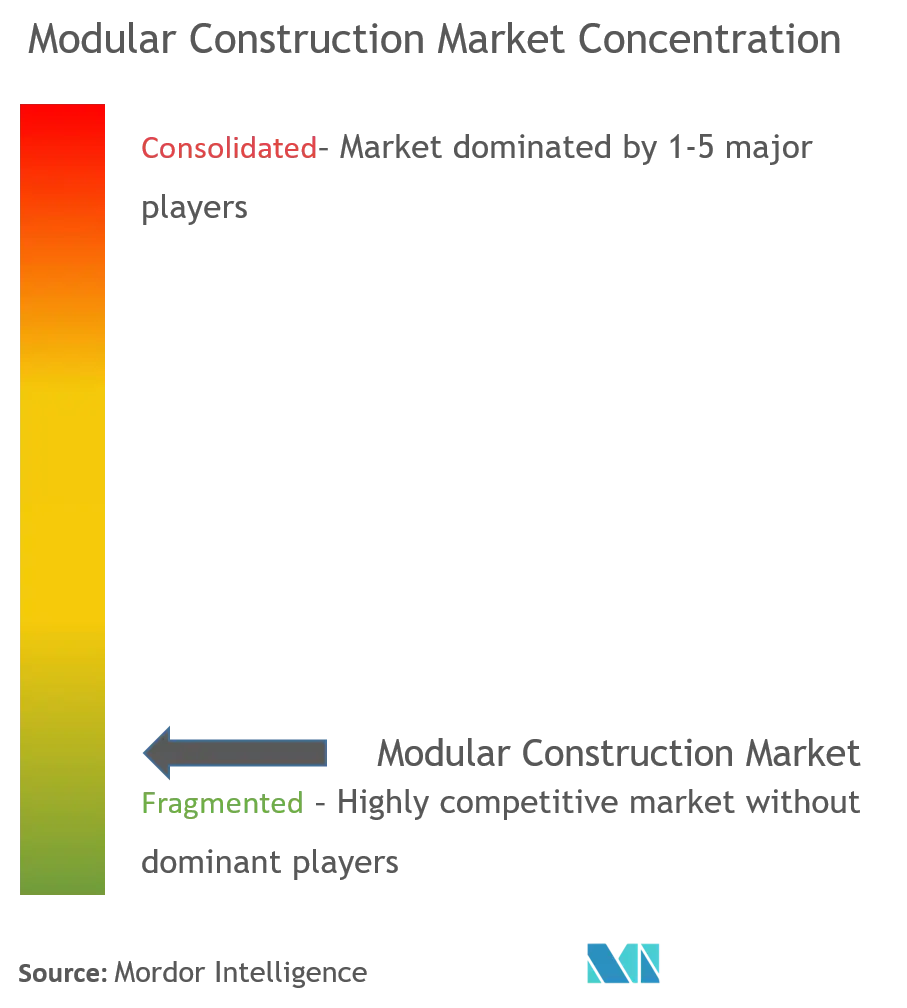
Modular Construction Market News
- In December 2022, Balfour Beatty signed a memorandum of understanding with Holtec Britain and Hyundai Engineering and Construction (HDEC) to develop small modular nuclear reactors in the United Kingdom.
- In October 2022, Balfour Beatty today announced that its 50:50 joint venture, Gammon, has been awarded an HKD 1.3 billion (USD 0.17 million) contract on behalf of Top Oasis Limited, a consortium formed by Sino Land Company Limited and CSI Properties Limited for the construction of a residential development in Yau Tong, Hong Kong.
Modular Construction Market Report - Table of Contents
1. INTRODUCTION
1.1 Study Assumptions
1.2 Scope of the Study
2. RESEARCH METHODOLOGY
3. EXECUTIVE SUMMARY
4. MARKET DYNAMICS
4.1 Drivers
4.1.1 Increasing Demand from the Construction Industries in Asia-Pacific Countries
4.1.2 Time and Cost-effective Method of Construction
4.1.3 Lower Defects and Rework
4.1.4 Dynamics of labor demand
4.1.5 Other Drivers
4.2 Restraints
4.2.1 High Cost of Logistics
4.2.2 Other Restraints
4.3 Industry Value Chain Analysis
4.4 Porter's Five Forces Analysis
4.4.1 Bargaining Power of Suppliers
4.4.2 Bargaining Power of Buyers
4.4.3 Threat of New Entrants
4.4.4 Threat of Substitute Products and Services
4.4.5 Degree of Competition
4.5 Production Process
4.6 Regulatory Policy Analysis
5. MARKET SEGMENTATION (Market Size in Value)
5.1 Construction
5.1.1 Permanent Modular
5.1.2 Relocatable Modular
5.2 Material
5.2.1 Steel
5.2.2 Concrete
5.2.3 Wood
5.2.4 Plastic
5.3 End-user Industry
5.3.1 Commercial
5.3.2 Industrial/Institutional
5.3.3 Residential
5.4 Geography
5.4.1 Asia-Pacific
5.4.1.1 China
5.4.1.2 India
5.4.1.3 Japan
5.4.1.4 South Korea
5.4.1.5 Rest of Asia-Pacific
5.4.2 North America
5.4.2.1 United States
5.4.2.2 Canada
5.4.2.3 Mexico
5.4.3 Europe
5.4.3.1 Germany
5.4.3.2 United Kingdom
5.4.3.3 France
5.4.3.4 Italy
5.4.3.5 Benelux Countries
5.4.3.6 Rest of Europe
5.4.4 South America
5.4.4.1 Brazil
5.4.4.2 Argentina
5.4.4.3 Rest of South America
5.4.5 Middle-East and Africa
5.4.5.1 Saudi Arabia
5.4.5.2 South Africa
5.4.5.3 Rest of Middle-East and Africa
6. COMPETITIVE LANDSCAPE
6.1 Mergers and Acquisitions, Joint Ventures, Colaborations, and Agreements
6.2 Market Share (%)**/Ranking Analysis
6.3 Strategies Adopted by Leading Players
6.4 Company Profiles
6.4.1 ACS Group
6.4.2 ATCO Ltd
6.4.3 Balfour Beatty
6.4.4 Bechtel Corporation
6.4.5 Bouygues Construction
6.4.6 Fluor Corporation
6.4.7 Guerdon, LLC
6.4.8 JL Construction
6.4.9 Julius Berger Nigeria PLC
6.4.10 Kiewit Corporation
6.4.11 Laing O'Rourke
6.4.12 Larsen & Toubro Limited
6.4.13 McGRATH RENTCORP
6.4.14 Palomar Modular Buildings
6.4.15 Red Sea Housing Services
6.4.16 SEKISUI CHEMICAL CO. LTD
6.4.17 Skanska
6.4.18 System House R & C Co. Ltd
6.4.19 Taisei Corporation
6.4.20 WillScot Mobile Mini Holdings Corp
- *List Not Exhaustive
7. MARKET OPPORTUNITIES AND FUTURE TRENDS
7.1 Implementation of Building Information Modeling (BIM)
7.2 Potential Savings in Cost Due to the Adoption of Modular Construction
Modular Construction Industry Segmentation
Modular construction involves the delivery and assembling of pre-fabricated engineered building units at the construction site. The volumetric building modular units are usually in the form of highly serviced units, such as kitchens, toilets, complete rooms, or parts of a room. The construction process of modular buildings is faster than the conventional process, as it requires less time. Furthermore, other advantages associated with modular construction include greater flexibility, improved air quality, and reduced construction schedule.
The modular construction market is segmented by construction, material, end-user industry, and geography. By construction, the market is segmented into permanent modular and relocatable modular. By material, the market is segmented into steel, concrete, wood, and plastic. By end-user industry, the market is segmented into commercial, industrial/institutional, and residential. The report also covers the market size and forecasts for the modular construction market in 15 countries across the major regions. For each segment, the market sizing and forecasts have been done based on revenue (USD).
| Construction | |
| Permanent Modular | |
| Relocatable Modular |
| Material | |
| Steel | |
| Concrete | |
| Wood | |
| Plastic |
| End-user Industry | |
| Commercial | |
| Industrial/Institutional | |
| Residential |
| Geography | ||||||||
| ||||||||
| ||||||||
| ||||||||
| ||||||||
|
Modular Construction Market Research FAQs
How big is the Modular Construction Market?
The Modular Construction Market size is expected to reach USD 63.76 billion in 2024 and grow at a CAGR of 8.78% to reach USD 97.13 billion by 2029.
What is the current Modular Construction Market size?
In 2024, the Modular Construction Market size is expected to reach USD 63.76 billion.
Who are the key players in Modular Construction Market?
Skanska, Bouygues Construction, WillScot Mobile Mini Holdings Corp. , ATCO Ltd and SEKISUI CHEMICAL CO., LTD are the major companies operating in the Modular Construction Market.
Which is the fastest growing region in Modular Construction Market?
Asia Pacific is estimated to grow at the highest CAGR over the forecast period (2024-2029).
Which region has the biggest share in Modular Construction Market?
In 2024, the Asia Pacific accounts for the largest market share in Modular Construction Market.
What years does this Modular Construction Market cover, and what was the market size in 2023?
In 2023, the Modular Construction Market size was estimated at USD 58.61 billion. The report covers the Modular Construction Market historical market size for years: 2019, 2020, 2021, 2022 and 2023. The report also forecasts the Modular Construction Market size for years: 2024, 2025, 2026, 2027, 2028 and 2029.
What are the challenges faced by the Modular Construction Industry?
The challenges faced by the Modular Construction Industry are a) Lack of proper recycling infrastructure b) Transportation and assembly issues c) Shortage of experts with specialized knowledge in modular construction d) Fluctuations in transportation costs e) Adapting to varying regulatory requirements in different regions
Modular Construction Industry Report
The modular construction market is experiencing significant growth, driven by its numerous advantages over traditional construction methods. This innovative approach involves prefabricating modules in controlled factory settings and assembling them on-site, which not only speeds up construction times but also enhances quality control and reduces costs. Top modular construction companies are leading the way in this sector, utilizing advanced technologies to deliver high-quality modular buildings. The market is segmented by type, material, and end-use industry, with permanent modular construction and wood material segments dominating due to their durability, aesthetic appeal, and sustainability. Globally, the market is witnessing a surge in demand across various sectors, particularly in residential and healthcare, driven by rapid urbanization and the need for efficient building solutions. Modular building companies are increasingly recognized for their ability to meet these demands quickly and sustainably. The Asia-Pacific region leads the market, propelled by urbanization, supportive government policies, and technological advancements in modular construction. The focus on enhancing workplace safety and sustainability continues to drive the modular construction industry forward. Obtain a free report PDF download from Mordor Intelligence™ Industry Reports, which provides a comprehensive analysis of the modular construction landscape.
